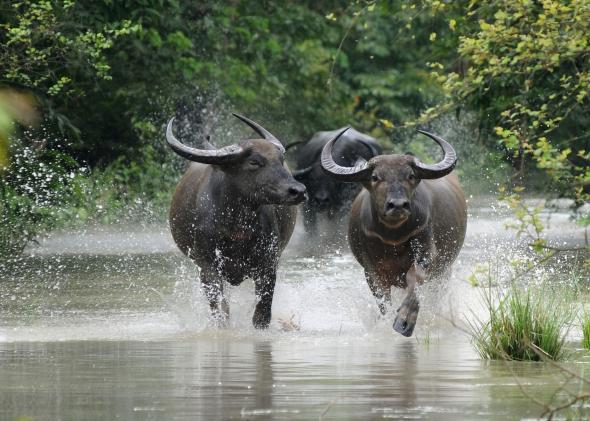Souvenir Sheet: European Bison (Bison bonasus) (Umm al-Qiwain 1972)
European Bison (Bison bonasus) (Umm al-Qiwain 1972)
01 January (Umm al-Qiwain ) within release Rare Animals (II), large format goes into circulation Souvenir Sheet European Bison (Bison bonasus) face value 1 Qatari riyal
| Souvenir Sheet European Bison (Bison bonasus) in catalogues | |
|---|---|
| Michel: | Mi: UM 1530AEBb |
| Colnect codes: | Col: UM 1972.00.00-293aa |
Souvenir Sheet is square format.
Blue frameAlso in the issue Rare Animals (II), large format:
- Stamp - Baird's Tapir (Tapirus bairdii) face value 1;
- Souvenir Sheet - Baird's Tapir (Tapirus bairdii) face value 1;
- Souvenir Sheet - Baird's Tapir (Tapirus bairdii) face value 1;
- Stamp - Black-footed Ferret (Mustela nigripes) face value 1;
- Souvenir Sheet - Black-footed Ferret (Mustela nigripes) face value 1;
- Souvenir Sheet - Black-footed Ferret (Mustela nigripes) face value 1;
- Stamp - Brown Bear (Ursus arctos) face value 1;
- Souvenir Sheet - Brown Bear (Ursus arctos) face value 1;
- Souvenir Sheet - Brown Bear (Ursus arctos) face value 1;
- Stamp - Chinchilla (Chinchilla sp.) face value 1;
- Souvenir Sheet - Chinchilla (Chinchilla sp.) face value 1;
- Souvenir Sheet - Chinchilla (Chinchilla sp.) face value 1;
- Stamp - European Bison (Bison bonasus) face value 1;
- Souvenir Sheet - European Bison (Bison bonasus) face value 1;
- Souvenir Sheet - European Bison (Bison bonasus) face value 1;
- Stamp - Gaur (Bos gaurus) face value 1;
- Souvenir Sheet - Gaur (Bos gaurus) face value 1;
- Souvenir Sheet - Gaur (Bos gaurus) face value 1;
- Stamp - Koala (Phascolarctos cinereus) face value 1;
- Souvenir Sheet - Koala (Phascolarctos cinereus) face value 1;
- Souvenir Sheet - Koala (Phascolarctos cinereus) face value 1;
- Stamp - Lemur variegatus face value 1;
- Souvenir Sheet - Lemur variegatus face value 1;
- Souvenir Sheet - Lemur variegatus face value 1;
- Stamp - Lowland Anoa (Bubalus depressicornis) face value 1;
- Souvenir Sheet - Lowland Anoa (Bubalus depressicornis) face value 1;
- Souvenir Sheet - Lowland Anoa (Bubalus depressicornis) face value 1;
- Stamp - Markhor (Capra falconeri) face value 1;
- Souvenir Sheet - Markhor (Capra falconeri) face value 1;
- Souvenir Sheet - Markhor (Capra falconeri) face value 1;
- Stamp - Numbat (Myrmecobius fasciatus) face value 1;
- Souvenir Sheet - Numbat (Myrmecobius fasciatus) face value 1;
- Souvenir Sheet - Numbat (Myrmecobius fasciatus) face value 1;
- Mini Sheet - Rare Animals face value 16*1;
- Souvenir Sheet - Red Deer (Cervus elaphus) face value 1;
- Souvenir Sheet - Red Deer (Cervus elaphus) face value 1;
- Stamp - Red Deer (Cervus elaphus) face value 1;
- Stamp - Spectacled Bear (Tremarctos ornatus) face value 1;
- Souvenir Sheet - Spectacled Bear (Tremarctos ornatus) face value 1;
- Souvenir Sheet - Spectacled Bear (Tremarctos ornatus) face value 1;
- Stamp - Sumatran Orangutan (Pongo sp.) face value 1;
- Souvenir Sheet - Sumatran Orangutan (Pongo sp.) face value 1;
- Souvenir Sheet - Sumatran Orangutan (Pongo sp.) face value 1;
- Stamp - Tasmanian Tiger (Thylacinus cynocephalus) face value 1;
- Souvenir Sheet - Tasmanian Tiger (Thylacinus cynocephalus) face value 1;
- Souvenir Sheet - Tasmanian Tiger (Thylacinus cynocephalus) face value 1;
- Stamp - Tiger Quoll (Dasyurus maculatus) face value 1;
- Souvenir Sheet - Tiger Quoll (Dasyurus maculatus) face value 1;
- Souvenir Sheet - Tiger Quoll (Dasyurus maculatus) face value 1;
Souvenir Sheet European Bison (Bison bonasus) it reflects the thematic directions:
Animals are multicellular, eukaryotic organisms of the kingdom Animalia (also called Metazoa). All animals are motile, meaning they can move spontaneously and independently, at some point in their lives. Their body plan eventually becomes fixed as they develop, although some undergo a process of metamorphosis later on in their lives. All animals are heterotrophs: they must ingest other organisms or their products for sustenance.
A bison (pl.: bison) is a large bovine in the genus Bison (from Greek, meaning 'wild ox') within the tribe Bovini. Two extant and numerous extinct species are recognised.
Bubalina is a subtribe of wild cattle that includes the various species of true buffalo. Species include the African buffalo, the anoas, and the wild water buffalo (including the domesticated variant water buffalo). Buffaloes can be found naturally in sub-Saharan Africa, South Asia and Southeast Asia, and domestic and feral populations have been introduced to Europe, the Americas, and Australia.In addition to the living species, bubalinans have an extensive fossil record where remains have been found in much of Afro-Eurasia
Mammals are any vertebrates within the class Mammalia (/məˈmeɪli.ə/ from Latin mamma "breast"), a clade of endothermic amniotes distinguished from reptiles (including birds) by the possession of a neocortex (a region of the brain), hair, three middle ear bones and mammary glands. All female mammals nurse their young with milk, secreted from the mammary glands. Mammals include the largest animals on the planet, the great whales. The basic body type is a terrestrial quadruped, but some mammals are adapted for life at sea, in the air, in trees, underground or on two legs. The largest group of mammals, the placentals, have a placenta, which enables the feeding of the fetus during gestation. Mammals range in size from the 30–40 mm (1.2–1.6 in) bumblebee bat to the 30-meter (98 ft) blue whale. With the exception of the five species of monotreme (egg-laying mammals), all modern mammals give birth to live young. Most mammals, including the six most species-rich orders, belong to the placental group. The largest orders are the rodents, bats and Soricomorpha (shrews and allies). The next three biggest orders, depending on the biological classification scheme used, are the Primates (apes and monkeys), the Cetartiodactyla (whales and even-toed ungulates), and the Carnivora (cats, dogs, seals, and allies).




